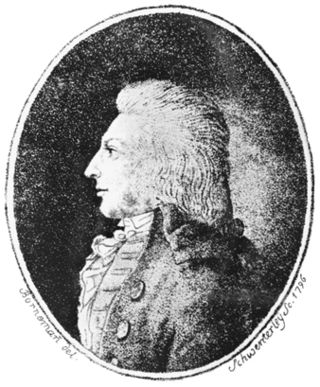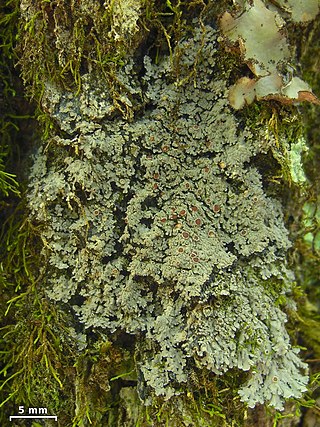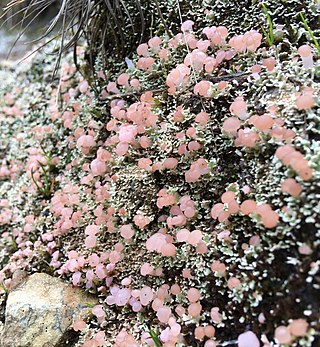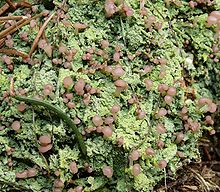
Christiaan Hendrik Persoon was a German mycologist who made additions to Linnaeus' mushroom taxonomy.
Graphium rigidum is a species of fungus in the family Microascaceae. It is a plant pathogen. The fungus was originally described as new to science in 1794 by Christiaan Hendrik Persoon, as Stilbum rigidum. Pier Andrea Saccardo transferred it to the genus Graphium in 1886.

Pycnothelia is a genus of lichen-forming fungi in the family Cladoniaceae. Pycnothelia was promoted to generic status by French naturalist Léon Jean Marie Dufour in 1821; it was originally circumscribed by Erik Acharius in 1799 as a section of the now-defunct genus Cenomyce.
Gymnoderma is a genus of lichen-forming fungi in the family Cladoniaceae. It has three species. The genus was circumscribed by Finnish botanist William Nylander in 1860. Nylander assigned Gymnoderma coccocarpum as the type species in 1869; this species was originally collected from the Himalayas. It occurs throughout southeastern Asia.

Fuscopannaria is a genus of lichen-forming fungi in the family Pannariaceae. It has 55 species.
Ancistrosporella is a genus of lichen-forming fungi in the family Roccellaceae. The genus was circumscribed in 1995 by Swedish lichenologist Göran Thor, with Ancistrosporella australiensis assigned as the type species.
Clavascidium is a genus of lichens in the family Verrucariaceae. The genus was circumscribed in 1996 by Austrian lichenologist Othmar Breuss. Because the type species of the genus, Clavascidium umbrinum, has been shown using molecular phylogenetics to belong to genus Placidium, Cécile Gueidan and colleagues proposed to unite Clavascidium with Placidium in a 2009 publication. Despite this, the genus has been retained in recent publications of fungal classification.

Catapyrenium is a genus of lichens in the family Verrucariaceae. The genus was circumscribed by German botanist Julius von Flotow in 1850.

Thyrea is a genus of lichen-forming fungi in the family Lichinaceae. It contains four species that have been accepted by Species Fungorum. The genus was circumscribed by Italian lichenologist Abramo Bartolommeo Massalongo in 1856, with Thyrea plectospora assigned as the type species.
Leciophysma is a genus of cyanolichens in the family Pannariaceae. It has four species. The genus was circumscribed by Theodor Magnus Fries in 1865, with Leciophysma finmarkicum assigned as the type species.

Catolechia is a genus of lichen-forming fungi in the family Rhizocarpaceae. It is a monotypic genus, containing the single species Catolechia wahlenbergii. The genus was circumscribed by German botanist Julius von Flotow in 1850. He did not assign a type species for the genus; Catolechia pulchellaA.Massal. (1852) was designated as the type by Gustav Wilhelm Körber in 1855. This species is synonymous with Catolechia wahlenbergii.
Nipholepis is a little-known fungal genus in the order Arthoniales. The genus has not been placed into a family. It is a monotypic genus, containing the single species Nipholepis filicina, found in Venezuela. Both the genus and species were described in 1935 by German mycologist Hans Sydow. Nipholepis filicina is an epiphytic fungus, living on the surface of plant leaves. Sydow found the fungus forming minute white flecks on the lower frond surfaces of the fern Diplazium expansum, the upper surface of which was covered in algae, mosses, and lichens. He noted a resemblance to the lichen Myxotheca hypocreoides, a member of the family Arthoniaceae.

Geoglossum is a genus of fungi in the family Geoglossaceae. They are commonly called earth tongues. The type species is Geoglossum glabrum. Geoglossum species are distinguished from the related genus Trichoglossum by the lack of setae on the spore bearing surface. Geoglossum species are characterized by dark, club-shaped, terrestrial ascocarps with a fertile hymenium continuing downward from the apex of the ascocarp along the stipe, eventually intergrading with a sterile stipe. The ascospores of Geoglossum range from translucent to dark brown, and are fusiform, and multiseptate. Identification of species is based on the gross morphology of the ascocarp, color and septation of the ascospores, and shape and ornamentation of the paraphyses.

Cladonia caespiticia is a widespread and common species of fruticose, cup lichen in the family Cladoniaceae. It was originally named Baeomyces caespiticius by German mycologist Christiaan Hendrik Persoon in 1794. Heinrich Gustav Flörke transferred it to the genus Cladonia in 1827. In North America, it is commonly known as the stubby-stalked Cladonia.

Phyllobaeis is a genus of lichen-forming fungi in the family Baeomycetaceae. It has six species. The genus was circumscribed by lichenologists Klaus Kalb and Claudia Gierl in 1993, with Phyllobaeis imbricata assigned as the type species. Phyllobaeis differs from Baeomyces by the production of the secondary chemical norstictic acid, as well as the tropical distribution of its species. Most species have a squamulose thallus, but the most recent addition to the genus–the Chinese species P. crustacea–has a crustose thallus.

Mastodia is a genus of lichen-forming fungi in the family Verrucariaceae. It has six species. The genus was circumscribed in 1847 by Joseph Dalton Hooker and William Henry Harvey. The type species, Mastodia tessellata, is a bipolar, coastal lichen. It forms a symbiotic association with the macroscopic genus Prasiola; this is the only known lichen symbiosis involving a foliose green alga. Studies suggest that throughout its geographic range, the lichen comprises two fungal species and three algal lineages that associate.
Pyrenidium is a genus of lichenicolous (lichen-dwelling) fungi. It is the only genus in the family Pyrenidiaceae. It has 13 species.
Moriola is a poorly-known genus of fungi in the family Verrucariaceae. It has 17 species. Members of the genus parasitise various algal species; some species are considered to be saprotrophic or "doubtfully lichenized".

Pseudoschismatomma is a monotypic fungal genus in the family Roccellaceae. It contains the single species Pseudoschismatomma rufescens, a corticolous (bark-dwelling), crustose lichen. This species was first described in 1794 by Christiaan Hendrik Persoon as Opegrapha rufescens. Pseudoschismatomma was circumscribed in 2014 by Damien Ernst and Anders Tehler, following molecular phylogenetic analysis and revision of the Roccellaceae. The genus name alludes to its similarity with genus Schismatomma, particularly S. graphidioides. It differs from this species in having a distinct brown true exciple.

Wetmoreana is a genus of lichen-forming fungi in the family Teloschistaceae. It has two crustose, saxicolous (rock-dwelling) species.












